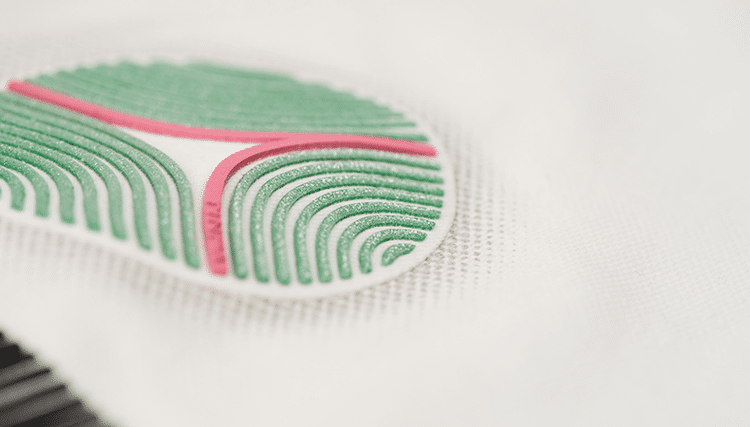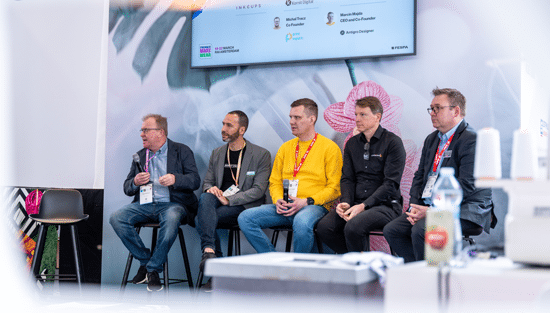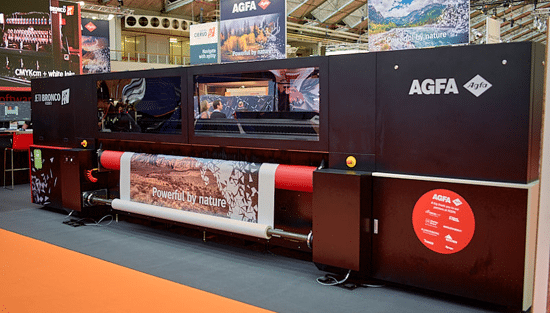The DNA of design: FESPA award-winning garment printing

Sincerely Screen Co in Thailand won a Bronze FESPA Award in the Printed Garments category for this complex lenticular design using silicone ink.
Sincerely Screen Co from Thailand won a FESPA award for this ‘DNA’ polo shirt. The shirt was decorated using silicone inks precisely stacked in layers to create a lenticular message that changes colour depending on the viewing angle. It also features its own security detail that appears when backlit.
What was your inspiration for this print?
The idea was to create apparel with printing technology that expresses the genetics of the owner who wears this t-shirt with the printing technique.
What technical issues did you need to overcome?
We used a high-density sandwich-printing technique, which is intentionally made to be seen through three different designs in one piece. By looking at the print differently, you will see three different designs from three angles. The individual shirt has its own specific genetic on the right logo that appears when using the backlight. Then the picture of the person who owns the t-shirt will also appear.
Ink: Silicone printTechnic: High-density printing with 2 separated designs.
Mesh: 43T
Layers: 50

When using sandwich printing, it is important to plan from the beginning during the design process to ensure that the 3D design that you see will occur. The print itself will show the view at different angles. The right side of the t-shirt print uses the technique of invisible colour printing that has the photo portrait of the owner of the t-shirt.
The printing sequence starts with printing on all three positions at the same time, after each position was printed, depending on the shade and chemistry. By considering the thickness of the printing position, where there is a density, the block and that colour must be repeated many times until the thickness meets the requirement. After all colours were printed, we cured the print in an oven.
This piece was created using two special techniques that are rarely seen in printed garments. Firstly, the shirt was screen printed in halftones using invisible ink to emphasise the identity of the owner of that piece of work.

By printing high-density, each layer needed to be printed many times and had to be printed with alternating colours on the left, center and right side, until the desired thickness was required.
The process
1. The ink that we used was Dow Corning silicone, Matsui and Dystar pigment.2. The ink we used was silicone and rubber, divided into 3 parts: right chest, left chest and middle print.
3. The logo on the right chest:
- Rubber print: 3 layers as a base.
- Next layer with invisible ink with photographs: 1 layer.
- Pink colour 1 layer, green colour 1 layer and black colour 2 layers.
- Silicone print with gradient: 1 layer.
- Silicone print green colour with high-density techniques: 45 layers.
- Silicone print red colour with high-density techniques: 45 layers.
- Silicone print glossy colour: 3 layers.
- Tinpa logo: silicone print 2 layers
- Black stripe with silicone ink high-density techniques: 65 layers.
- Black, green and red silicone ink with high-density techniques: print 45 layers in each colour. But those three colours had to be printed in an arranged order by black-green-red until 135 layers were created.
- Black stripe with silicone ink high-density techniques: 45 layers.
7. We used a conveyor belt for curing at 130°C with two minutes in each layer using an Adelco curing machine.
8. We used halftones to separate the design with Photoshop and Illustrator.
Become a FESPA member to continue reading
To read more and access exclusive content on the Club FESPA portal, please contact your Local Association. If you are not a current member, please enquire here. If there is no FESPA Association in your country, you can join FESPA Direct. Once you become a FESPA member, you can gain access to the Club FESPA Portal.
Topics
Recent news

The personal touch: visit Personalisation Experience’s SmartHub Conference 2025
Join the SmartHub Conference at Personalisation Experience next month to stay ahead of the latest tech and trends.

How to build brand trust using customer reviews
Reviews can benefit or damage your business’s reputation. From spreading the word to social proof, here is why reviews matter and what you can do to manage your customer reviews to improve your brand’s reputation.

Regulation guidance: Extended Producer Responsibility
Extended Producer Responsibility (EPR) is now in effect. What does it mean for those in the print industry? Sustainability consultant Rachel England outlines everything you need to know.

How to maximise the automation of your production workflow
Workflow automation has evolved beyond basic file prep, now encompassing job submission, prepress, and postpress. Printers automate to boost productivity, cut waste, and address skill shortages. Implementing tailored automation, from RIPs to MIS, optimises throughput and profitability, minimising human intervention.